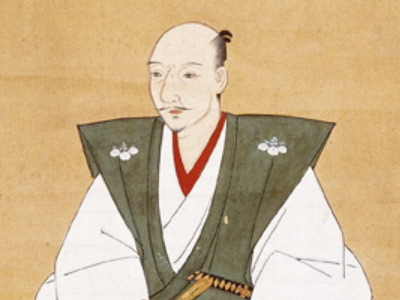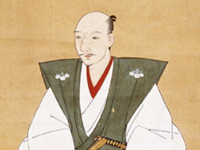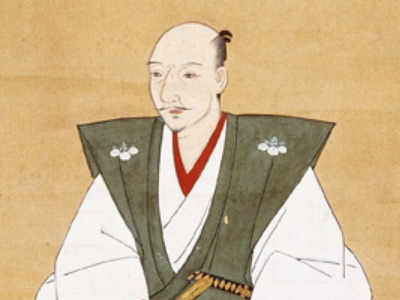Oda Nobunaga (1534-1582)

Campaign against rival daimyō
Battle of Anegawa
The Asakura clan was particularly disdainful of the Oda clan's increasing power. Furthermore, Asakura Yoshikage had also protected Ashikaga Yoshiaki, but had not been willing to march toward Kyoto.
When Nobunaga launched a campaign into the Asakura clan's domain, Azai Nagamasa, to whom Oichi was married, broke the alliance with Oda to honor the Azai-Asakura alliance which had lasted for generations. With the help of Ikko rebels, the anti-Nobunaga alliance sprang into full force, taking a heavy toll on the Oda clan. At the Battle of Anegawa, Tokugawa Ieyasu joined forces with Nobunaga and defeated the combined forces of the Asakura and Azai clans.
The Enryaku-ji monastery on Mt. Hiei, with its sōhei (warrior monks) of the Tendai school who aided the anti-Nobunaga group by helping Azai-Asakura alliance, was an issue for Nobunaga since the monastery was so close to his base of power. Nobunaga attacked Enryaku-ji and razed it in Oct. 1571, killing "monks, laymen, women and children" in the process. The whole mountainside was a great slaughterhouse, and the sight was one of unbearable horror."
Siege of Nagashima and Ishiyama Hongan-ji
During the siege of Nagashima, Nobunaga inflicted tremendous losses to the Ikkō-ikki resistance who opposed samurai rule. The siege finally ended when Nobunaga surrounded the enemy complex and set fire to it, killing tens of thousands.
He later succeeded in taking their main stronghold at Ishiyama Hongan-ji after an 11-year siege that ended with its surrender.
Battle of Nagashino
One of the strongest rulers in the anti-Nobunaga alliance was Takeda Shingen, in spite of his generally peaceful relationship and a nominal alliance with the Oda clan. In 1572, at the urgings of the Shogun, Shingen decided to make a drive for the capital starting with invading Tokugawa territory. Tied down on the Western front, Nobunaga sent lackluster aid to Ieyasu, who suffered defeat at the Battle of Mikatagahara in 1573. However, after the battle, Tokugawa's forces launched night raids and convinced Takeda of an imminent counter-attack, thus saving the vulnerable Tokugawa with the bluff. This would play a pivotal role in Tokugawa's philosophy of strategic patience in his campaigns with Oda Nobunaga. Shortly thereafter, the Takeda forces were neutralized after Shingen died from Esophageal cancer in April 1573.
This was a relief for Nobunaga because he could now focus on Yoshiaki, who had openly declared hostility more than once, despite the imperial court's intervention. Nobunaga was able to defeat Yoshiaki's forces and send him into exile, bringing the Ashikaga shogunate to an end in the same year.
Also in 1573, Nobunaga successfully destroyed the Asakura and Azai clans, leading Azai Nagamasa to send Oichi back to Nobunaga and commit suicide. With Nagashima's destruction in 1574, the only threat to Nobunaga was the Takeda clan, now led by Takeda Katsuyori.
At the decisive Battle of Nagashino, the combined forces of Nobunaga and Tokugawa Ieyasu devastated the Takeda clan with the strategic use of arquebuses. Nobunaga compensated for the arquebus's slow reloading time by arranging the arquebusiers in three lines. After each line fired, it would duck and reload as the next line fired. The bullets were able to pierce the Takeda cavalry armor, who were pushed back and killed by incoming fire. From there, Nobunaga continued his expansion, sending Shibata Katsuie and Maeda Toshiie to the north and Akechi Mitsuhide to Tanba Province.
Surrender of Ishiyama Hongan-ji
In 1574 Nobunaga became Gondainagon and Ukon'etaishō. By 1576 he was given the title of Minister of the Right (Udaijin). The Oda clan's siege of Ishiyama Hongan-ji in Osaka made some progress, but the Mori clan of the Chūgoku region broke the naval blockade and started sending supplies into the strongly fortified complex by sea. As a result, in 1577, Hashiba Hideyoshi was ordered to expand west to confront the Mori clan.
However, Uesugi Kenshin, said to be the greatest general of his time since the demise of Takeda Shingen, took part in the second anti-Oda alliance. Following his conquest of neighboring forces, the two sides clashed during the Battle of Tedorigawa which resulted in a decisive Uesugi victory. It was around this time that Uesugi forces began preparations to march on Kyoto.
Due to his defeat, Nobunaga's expansion in Noto, Kaga, and Etchū Province area stagnated. But Kenshin, who prepared to move his armies again after the battle, died from a possible cerebral hemorrhage before moving them. After Kenshin's death and much confusion among his successors, Nobunaga started his campaign again on this area.
Nobunaga forced the Ishiyama Hongan-ji to surrender in 1580 and destroyed the Takeda clan in 1582. Nobunaga's administration was at its height of power and he was about to launch invasions into Echigo Province and Shikoku.
HISTORY

RESOURCES
This article uses material from the Wikipedia article "Oda Nobunaga (1534-1582)", which is released under the Creative Commons Attribution-Share-Alike License 3.0.
© Stories Preschool. All Rights Reserved.









